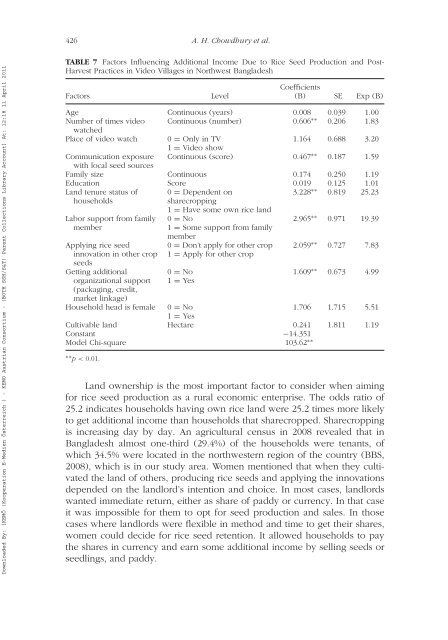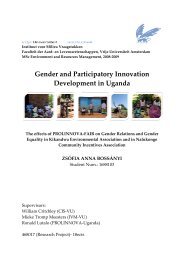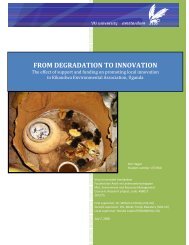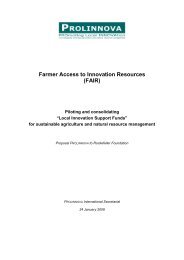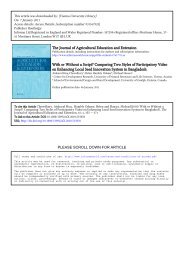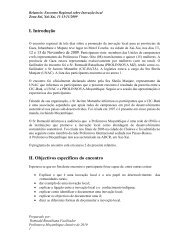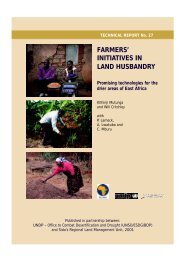Chowdhury et al (2011); PDF file - Prolinnova
Chowdhury et al (2011); PDF file - Prolinnova
Chowdhury et al (2011); PDF file - Prolinnova
Create successful ePaper yourself
Turn your PDF publications into a flip-book with our unique Google optimized e-Paper software.
426 A. H. <strong>Chowdhury</strong> <strong>et</strong> <strong>al</strong>.<br />
Downloaded By: [KEMÖ (Kooperation E-Medien Österreich ) - KEMO Austrian Consortium - (BOTH SSH/S&T) Parent Collections Library Account] At: 12:18 11 April <strong>2011</strong><br />
TABLE 7 Factors Influencing Addition<strong>al</strong> Income Due to Rice Seed Production and Post-<br />
Harvest Practices in Video Villages in Northwest Bangladesh<br />
Factors<br />
Level<br />
Coefficients<br />
(B) SE Exp (B)<br />
Age Continuous (years) 0.008 0.039 1.00<br />
Number of times video Continuous (number) 0.606 ∗∗ 0.206 1.83<br />
watched<br />
Place of video watch 0 = Only in TV<br />
1.164 0.688 3.20<br />
1 = Video show<br />
Communication exposure Continuous (score) 0.467 ∗∗ 0.187 1.59<br />
with loc<strong>al</strong> seed sources<br />
Family size Continuous 0.174 0.250 1.19<br />
Education Score 0.019 0.125 1.01<br />
Land tenure status of<br />
households<br />
0 = Dependent on<br />
sharecropping<br />
3.228 ∗∗ 0.819 25.23<br />
Labor support from family<br />
member<br />
Applying rice seed<br />
innovation in other crop<br />
seeds<br />
G<strong>et</strong>ting addition<strong>al</strong><br />
organization<strong>al</strong> support<br />
(packaging, credit,<br />
mark<strong>et</strong> linkage)<br />
Household head is fem<strong>al</strong>e<br />
1 = Have some own rice land<br />
0 = No<br />
1 = Some support from family<br />
member<br />
0 = Don’t apply for other crop<br />
1 = Apply for other crop<br />
0 = No<br />
1 = Yes<br />
2.965 ∗∗ 0.971 19.39<br />
2.059 ∗∗ 0.727 7.83<br />
1.609 ∗∗ 0.673 4.99<br />
0 = No<br />
1.706 1.715 5.51<br />
1 = Yes<br />
Cultivable land Hectare 0.241 1.811 1.19<br />
Constant −14.351<br />
Model Chi-square<br />
103.62 ∗∗<br />
∗∗ p < 0.01.<br />
Land ownership is the most important factor to consider when aiming<br />
for rice seed production as a rur<strong>al</strong> economic enterprise. The odds ratio of<br />
25.2 indicates households having own rice land were 25.2 times more likely<br />
to g<strong>et</strong> addition<strong>al</strong> income than households that sharecropped. Sharecropping<br />
is increasing day by day. An agricultur<strong>al</strong> census in 2008 reve<strong>al</strong>ed that in<br />
Bangladesh <strong>al</strong>most one-third (29.4%) of the households were tenants, of<br />
which 34.5% were located in the northwestern region of the country (BBS,<br />
2008), which is in our study area. Women mentioned that when they cultivated<br />
the land of others, producing rice seeds and applying the innovations<br />
depended on the landlord’s intention and choice. In most cases, landlords<br />
wanted immediate r<strong>et</strong>urn, either as share of paddy or currency. In that case<br />
it was impossible for them to opt for seed production and s<strong>al</strong>es. In those<br />
cases where landlords were flexible in m<strong>et</strong>hod and time to g<strong>et</strong> their shares,<br />
women could decide for rice seed r<strong>et</strong>ention. It <strong>al</strong>lowed households to pay<br />
the shares in currency and earn some addition<strong>al</strong> income by selling seeds or<br />
seedlings, and paddy.


